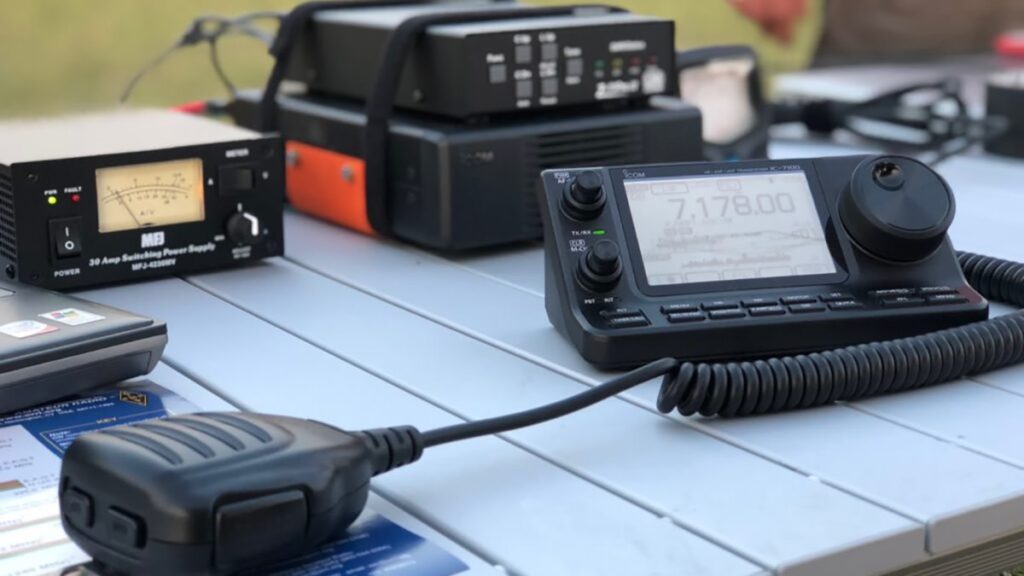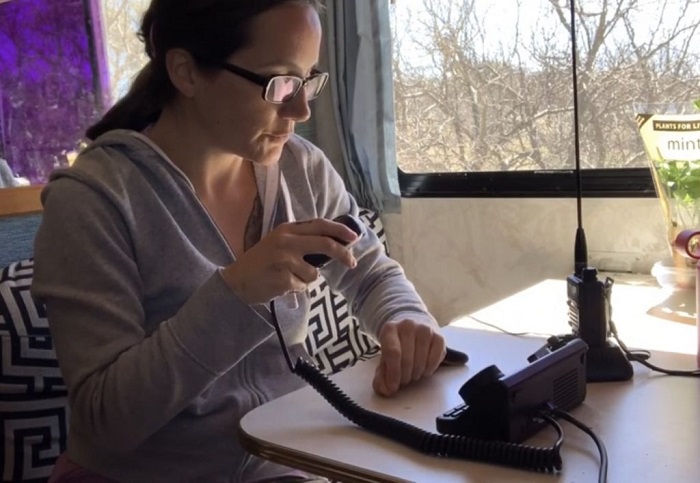
Are you a ham? Looking for some ham radio frequencies to program into your radio? Then you’ve come to the right place!
I’m a huge fan of ham radio. It has opened up our world to communication on a whole other level. We used to be die hard CB people until our friend kept telling us over and over again how horrible CB was compared to ham. He convinced us to finally get our licenses (my husband and I had both wanted to get it for a long while, but felt satisfied with our setup and never bothered). We now see what he was talking about. Trust me when I tell you that ham is the world you want to be in.
When it comes to reaching out to others, it might feel a little complicated at first. Not to mention intimidating. If you’ve passed your ham exam, then chances are you’ve got a basic idea of how ham works; but the real learning begins when you start making contacts.
The Ham Community
The ham community is friendly, knowledgeable, and eager to help. If you don’t understand something, just ask! If you flub, they’ll politely let you know. It’s all for the greater good of creating a courteous, knowledge ham community.
I want to encourage you to visit your local ham club (find one here). They are an invaluable source of never ending information. The internet can be great, but they’ll know the local lay of the land and point you in the right directions, introduce you to the community and so on.
Remember, you can always listen without a license. However, I strongly encourage you to get your license so you can engage and really learn the ins and outs of ham radio.
Finding Ham Radio Frequencies
When it comes to finding frequencies, there are a couple things we want to keep in mind:
- Are we looking to make contacts with other people?
- Or are we looking to find a frequency with no one else on it?
You may desire both. Regardless, consider programming these frequencies using CHIRP.
If you want to reach other people, you’ll go to where the people are. There are quite a few national frequencies, as well as local frequencies to connect with others.

National Frequencies
The national simplex calling frequency for 2 meters is 146.520 MHz. Generally, any frequency between 144-148 on 2 meter is pretty active. 70cm national national simplex calling frequency band would be 446.000 MHz. Common courtesy on national calling frequencies is to establish a contact and then move onto another frequency for others to establish their contacts. The national frequencies are a great place to get familiar with ham radio.
Local Frequencies
The best way to find local frequencies is to download the app RepeaterBook. It will find your location and instantly tell you the local repeaters around your area. You’ll then program those into your radio. You can also chat with the local ham clubs to learn about nets and to learn about anything else going on with the local ham community.
If you want to find a frequency that you can use to communicate with, say, your hunting group and not disturb others, finding a more “private” frequency might be a good idea.
Finding Unused Frequencies
Do not use a known repeater frequency or a known calling frequency such as the national calling frequency. You can also double check with the Band Plan. Best practice would be to pick a frequency, monitor it for a few minutes, try to call out, monitor for a few more minutes, call out again, etc. You can do this as many times as you’d like to feel comfortable that no one is there. Though be aware that even though it’s not being actively used, it may be in the future. And anyone could find it and pop in to listen. Never divulge personal or confidential information, unless you’re in trouble. Keep an ear open and be courteous.
Ham Radios are Great for Preppers
The frequencies I’ve mentioned so far are available to anyone with a technician license. If you have a general or extra, the world of meter bands, frequencies and general reach certainly opens up.
I would encourage all prepper to become ham operators and to go to a field day at least once. It’s a great way to learn, connect with local hams and make contacts, potentially all over the world!
You may choose to have your radio on all the time to be constantly listening. You may choose to only turn it on every so on to reach out and chat for a minute. It’s up to you and your general desires with what you want to do with ham radio.
Program the local frequencies as well as nearby and national frequencies. If your radio or program allows you to label what the frequency is, even better. Get them loaded in now so you’re not scrambling to find them later when you really need them.
Is owning and operating a ham radio too much? You should consider some type of alternate information-gathering device that isn’t reliant on the internet. Police scanners are great for home preparedness and bug out bags, as an example. They will help keep you one step ahead of others when critical information is coming in.
Are you a ham? Sound off in the comments section!
15 comments
Thanks for the article. I will download that app today.
I just passed my technicians exam last night. Thye learning has only begun. About all I know how to do is turn my set on and use it as a police scanner. The learning will begin once I have my license and can actually start communicating with other hams in my area. I met a few last night at the club where I took my test. It’s a really great community.
I’ve been a TechNoCode for 15 years now and I’ve got to suggest change toe polarization on your 70cm antenna to find a whole new crowd on 440. Vertical is ok if you going for repeater work but there is/are more clandestine operators out there using horizontal polarization. It is possible to hear and participate in conversations you will not hear any other way. You might want to build a small Yagi to do this as I don’t know if a mag mount will do the trick. QST magazine had an article on this a few years back and it was very interesting.
I`be been active in electronics in some form for over 35 years. Considering ham tech lie since soon .
Society of Promotion of Elfish Welfare? Harry and Ron i guess
As an acolyte of the late great patriot researcher, father of the modern patriot militia conspiracy truth movement Bill Cooper who ran a low power shortwave radio broadcast that bounced off of satellites from a deal he had with a company in Arizona, taught us one did not need a license as it was a question of jurisdiction and the Gestapo FCC lacked it sorely. He was transmitting locally and did not tread on any reserved or first responder frequencies. My life and knowledge changed immensely. Sadly they murder folk like him and we must never forget and step up too..
Amen brother
I just bought a couple of Baofeng UV-82 2-way radios and am just starting to learn about them. Most people start with Baofeng UV-5Rs (in any one of their different variations) and use them in their but out bags. Because the 5Rs are so popular, I bought a couple of the blue models and love the colors. Still, despite their popularity, what they lack in durability they more than make up for in charm. So I have three UV-82s with 3800 mAh batteries with USB connectors, which make solar connections easier.
So, being new to all this is very much like getting my Zorba cp/m computer, which I bought in the 80s. The UV-82s are sure purty, but I have no idea what to do with them. If I want to listen for awhile, how do I go about it?
Can anyone help? Point me in the right direction? I understand the cost of a license will soon come down from $70 to $35 or so?
When is that supposed to happen? In the meantime, is there anything I can do. Are there any channels or frequencies I can use legally?
Thanks! Great site.
Hey bro I would highly recommend you check out a guy named Josh on YT. His channel is Ham Radio Crash Course. He is arguably the most knowledgeable on the subject. I learned a lot of him. Whether you are a beginner Ham enthusiast or a seasoned one, he got you. Congrats on your purchase of nice comms..
If your a new ham or a seasoned ham and looking for some quiet freqs. try 147.39 to 147.60. I’ve used them for years even in the congested state of NJ. Most hams have ever spun the tuning dial that far. Nice and quiet.
Thinking of purchasing one? For my bug out bag ? As I’m prepping for any type of chaos in world affairs!!
Any suggestions on type /make /models of radio ? Cheap? Or more expensive?? I’ve no idea ? Help /advise please ?!!!!thanks all x.
If you’re very new to it, start with the handheld Baofeng UV-5R. It’s not high-end, but with a few upgrades it’ll be functional and it’s at a good price point where you can experiment with one and not break the bank: https://prepperpress.com/a-better-baofeng-uv-5r-instruction-manual/
Well thanks Derrick ! I ordered two of the barge g tri band with the fm function as may as well have local radio broadcasts as well . One for my pal so we can both try to figure these things out as not being that particularly techno savvy myself being nearly 50 I suppose I’m starting kinda late ! But due to my prepping activities I thought it prudent to add one to my bug out stuff as the worlds getting more unstable by the day . I’ll keep posting my progress, keep me in the loop guys n gals x
Comment about the picture working the hams at the kitchen counter. Is that a separate base system from the handheld? Just looking into it myself and was wondering if there’s an advantage to that set up. Thanks for your time.
It’s a small unit used in a camper. I don’t know the exact model, but it’s more convenient to speak on.